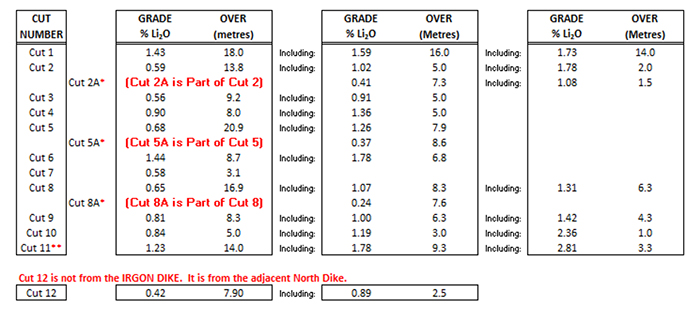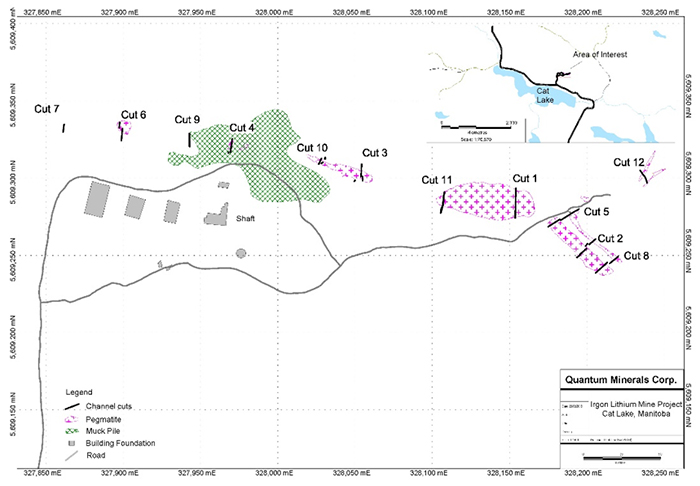Vancouver, British Columbia based QMC Quantum Minerals Corp., (TSX.V: QMC) (FSE: 3LQ) (OTC PINK: QMCQF) reported today that the company has received very positive assay results from the recent channel sampling program undertaken on the Irgon Dike at the company’s 100% owned Irgon Lithium Mine Project, S.E. Manitoba.
HIGHLIGHTS:
- 144 channel samples (over 139.1m) were obtained from 11 sawn channel cuts across the width of the Irgon Dike (Figure 1).
- The best channel sample interval returned 1.43% Li2O over 18.0m - including 1.73% Li2O over 14.0m.
- Lithium grades of up to 4.31%, 4.0% and 3.05% Li2O over one metre intervals were reported in the assay results.
* 22.2% of the pegmatite assays returned a grade greater than 1.5% Li2O.
* 41.1% of the pegmatite assays returned a grade greater than 1.0% Li2O.
* 54.4% of the pegmatite assays returned a grade greater than 0.5% Li2O.
- Tantalum (Ta), Niobium (Nb), Rubidium(Rb), Cesium (Cs) and Beryllium (Be) grades of up to 319, 275, 2961, 567 and 325 ppm respectively were encountered over one-meter sample intervals.
- The interval exhibiting the highest tantalum assay was from Cut 3: it returned 225ppm Ta over 5.6m.
- The interval exhibiting the highest cesium assay was from Cut 8: it returned 376ppm Cs over 4.7m.
- The interval exhibiting the highest niobium assay was from Cut 3: it returned 166ppm Nb over 4.0m.
A summary of complete Li2O results is tabulated below:
IRGON DIKE Li2O CHANNEL SAMPLING SUMMARY TABLE

* NOTE: Cuts 2A, 5A and 8A are part of Cuts 2, 5 and 8 respectively; however, they are separated out as the dike bifurcates at these sites and the “A” section predominantly consists of the central raft of (Li-bearing) mafic volcanic host rock.
** NOTE: Cut 11 was unable to be sawn across the entire width of the pegmatite dike as its northern contact was not accessible due to being covered by muskeg.
All samples were analyzed by SGS Labs in Lakefield, Ontario using a sodium peroxide fusion and subsequent ICP-AES and ICP MS scans for 56 elements including Li, Ta, Nb, Cs, Rb and Be - all elements which may potentially be found within the Winnipeg River area rare element-bearing pegmatites. Figure 1 below illustrates the outcrop trace of the Irgon Dike and the locations of the sawn channel sample cuts.
Cuts 2, 5 and 8 (indicated by the * in the above table) were obtained at the very eastern exposed extremity of the dike on surface. The dike here has begun to finger into the host basaltic wall rock. At surface level, the width of the dike is reduced as it appears to bifurcate; however, the pegmatite dike remains host to significant spodumene (lithium) mineralization.
Cut 1, located approximately 71m west of Cut 8 (the easternmost sample site) was taken across the widest exposed section of the dike, the best interval which reported 14m at 1.73% Li2O.
Overall sampling on surface indicates the spodumene mineralization is uniform both in abundance and crystal size. Spodumene mineralization is fairly ubiquitous throughout the dike and its crystal length is generally around 3-5cm which greatly reduces any inherent “nugget effect” that would occur with the presence of much larger crystals that generally occur in pegmatites.
The company is also encouraged by the tantalum grades that have been received by the surface sampling. Mineralization remains open in all directions.
Where rafts of host rock were encountered within the boundaries of the Irgon Dike on the surface, the company separated the different lithologies but included the mafic rafts as part of the calculated grade of the cut. These basaltic rafts samples, although separated from the pegmatite samples, returned anomalous values of Li2O to 0.77% and cesium to 567ppm.
QMC’s surface results confirm both the consistency and continuity of the spodumene mineralization and the contained Li2O content within the dike at surface. The current QMC results compare very favourably to the historic assays reported by the 1956 Manitoba Assessment Report (AR94932) obtained from the historical drilling and underground crosscut sampling.

Figure 1. Channel sample locations on the Irgon Pegmatite Dike, Cat Lake Area, S.E. Manitoba.
HISTORICAL RESOURCE
Between 1953-1954, the Lithium Corporation of Canada Limited drilled 25 holes into the Irgon Dike and subsequently reported a historical resource estimate of 1.2 million tons grading 1.51% Li20 over a strike length of 365 meters and to a depth of 213 meters (Northern Miner, Vol. 41, no.19, Aug. 4, 1955, p.3). This historical resource is documented in a 1956 Assessment Report by B. B. Bannatyne for the Lithium Corporation of Canada Ltd. (Manitoba Assessment Report No. 94932). This historical estimate is believed to be based on reasonable assumptions and neither the company nor the QP have any reason to contest the document’s relevance and reliability. The ongoing detailed channel sampling and a subsequent drill program will be required to update this historical resource to current NI 43-101 standards. Historic metallurgical tests reported an 87% recovery from which a concentrate averaging 5.9% Li2O was obtained.
During this historical 1950 era work program, a complete mining plant was installed on site designed to process 500 tons of ore per day and in addition, a three-compartment shaft was sunk to a depth of 74 meters. On the 61-metre level, lateral development was extended off the shaft for a total of 366 meters of drifting from which six crosscuts transected the dike. The work was suspended in 1957, awaiting a more favourable market for lithium oxides and at this time the mine buildings were removed.
The mineral reserve cited above is presented as a historical estimate and uses historical terminology which does not conform to current NI43-101 standards. A qualified person has not done sufficient work to classify the historical estimate as current mineral resources or mineral reserves. Although the historical estimates are believed to be based on reasonable assumptions, they were calculated prior to the implementation of National Instrument 43-101. These historical estimates do not meet current standards as defined under sections 1.2 and 1.3 of NI 43-101; consequently, the issuer is not treating the historical estimate as current mineral resources or mineral reserves.
Qualified Person and NI 43-101 Disclosure
The technical content of this news release has been reviewed and approved by Bruce E. Goad, P. Geo. who is a qualified person as defined by National Instrument 43-101.
About the Company
QMC is a British Columbia based company engaged in the business of acquisition, exploration and development of resource properties. Its objective is to locate and develop economic precious, base, rare metal and resource properties of merit. The Company’s properties include the Irgon Lithium Mine project two VMS properties, the Rocky Lake and Rocky-Namew known collectively as the Namew Lake District Project. Currently, all of the company’s properties are located in Manitoba.
On behalf of the Board of Directors of
QMC QUANTUM MINERALS CORP.
“Balraj Mann”
Balraj Mann
President and Chief Executive Officer
Neither the TSX Venture Exchange nor its Regulation Services Provider (as that term is defined in policies of the TSX Venture Exchange) accepts responsibility for the adequacy or accuracy of this news release.
Disclaimer
Nothing in this publication should be considered as personalized financial advice. We are not licensed under securities laws to address your particular financial situation. No communication by our employees to you should be deemed as personalized financial advice. Please consult a licensed financial advisor before making any investment decision. This is a paid advertisement and is neither an offer nor recommendation to buy or sell any security. We hold no investment licenses and are thus neither licensed nor qualified to provide investment advice. The content in this article is not provided to any individual with a view toward their individual circumstances. Baystreet.ca has been paid a fee of ten thousand dollars for QMC Quantum Minerals advertising and digital media. This compensation constitutes a conflict of interest as to our ability to remain objective in our communication regarding the profiled company. Because of this conflict, individuals are strongly encouraged to not use this newsletter as the basis for any investment decision. While all information is believed to be reliable, it is not guaranteed by us to be accurate. Individuals should assume that all information contained in our newsletter is not trustworthy unless verified by their own independent research. Also, because events and circumstances frequently do not occur as expected, there will likely be differences between any predictions and actual results. Always consult a licensed investment professional before making any investment decision. Be extremely careful, investing in securities carries a high degree of risk; you may likely lose some or all of the investment.